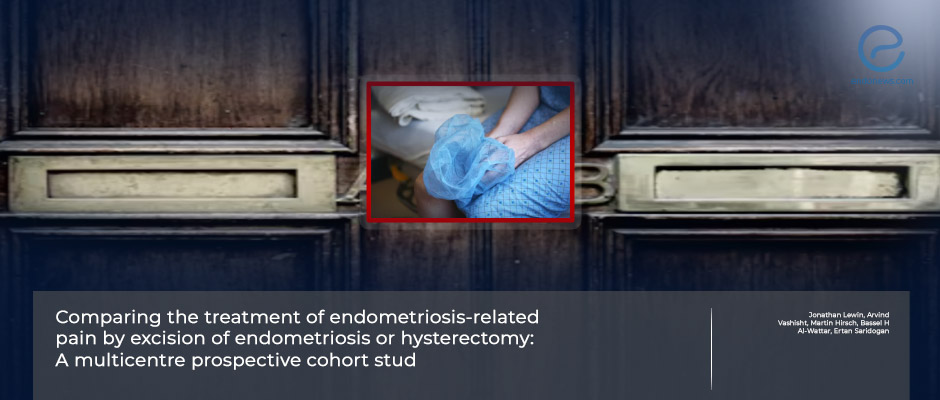Superiority of hysterectomy over lesion excision in the treatment of rectovaginal endometriosis
Aug 2, 2024
Pelvic excision plus hysterectomy improves quality of life and decreases pain in women with deeply infiltrating endometriosis.\
Key Points
Importance:
- Only endometriotic lesion excision may not improve the quality of life in endometriosis patients.
Highlights:
- The study provides an additional benefit of performing a total hysterectomy with endometriosis excision to treat endometriosis-related pain and quality of life.
- However, the same emphasis for the excision+hysterectomy+bilateral oophorectomy surgery may be controversial due to postoperative complications.
What's done here:
- This multicenter prospective cohort study was set up in 86 BSGE-accredited endometriosis centers in the UK, US, Sri Lanka, Iran, SA, and Turkey.
- The study population was formed by women who underwent rectovaginal endometriosis surgery between 2009 and 2020 in those centers.
- The effectiveness of 3 different surgical approaches (excision alone, with hysterectomy, and adding oophorectomies to the previous ones) were compared to treat endometriosis symptoms.
- The authors used the British Society for Gynecological Endoscopy database to compare the outcomes of those surgeries.
- Patients were asked to complete the questionnaire form to score the pain, voiding functions, and menstrual complaints preoperatively, and at 6,12, and 24 m after the surgery.
Key Results:
- The study population consisted of 8442 surgical cases from 86 registered centers.
- Three-fourths were lesion excision alone; 12,7% had additional hysterectomies; and 7,7% had excision+ hysterectomy+ oophorectomies.
- Overall follow-up rates were 85,8% at six months, and 64,5% at 12 months, and the patients with total hysterectomy and bilateral oophorectomy had higher follow-up rates.
- Patients who underwent excision of lesions and hysterectomy showed a prominent improvement in pain at postoperative 6 months, 12 months, and 24 months.
Lay Summary
Confirmative treatment of endometriosis includes excision or ablation of visible lesions while conserving the uterus and ovaries. On the contrary, the radical approach involves total hysterectomy and even bilateral oophorectomy to create a hypo-estrogen state, remove adenomyosis if it exists, and lead to amenorrhea. These radical processes carry both a high risk of postoperative complications and subsequent cardiovascular diseases and osteoporosis due to surgical menopause. Despite its potential disadvantages, the radical method aims to relieve the symptoms, remit the disease, and reduce further intervention.
Lewin et al. from the University College London Hospital, United Kingdom, aimed to compare surgical diversity's effectiveness in managing endometriosis and collected data from 8442 patients in 86 British Society for Gynecological Endoscopy accredited centers. They used a questionnaire to determine the postoperative improvement of pain and other symptoms in three operation groups: excision alone, excision with hysterectomy, and excisions+hystecrectomy+oophorectomy.
The results were compared statistically, and the surgical group, which included lesion excision and hysterectomy together, was superior in improving lower back pain, pelvic pain, and dyspareunia postoperatively at 6, 12, and 24 months.
Another statistically significant difference was that the excision + hysterectomy + oophorectomy group showed great improvement from their pre-operative scores about non-cyclical pelvic pain, dyspareunia, and lower pain at 6, 12, and 24 months. This group also showed a significant improvement in non-cyclical dyschezia compared to the excision-alone group.
In the cohort, pain scores at 6, 12, and 24 months significantly improved compared to the baseline. When it comes to postoperative complications, patients undergoing hysterectomy with ovarian conservation had higher odds of ureteric injuries, conversion to laparotomy, and pelvic hematoma compared to patients who had excision-alone surgery. The third group, the excision-hysterectomy+oopherectomy group, also had higher odds of hemorrhage, ureteric injuries, conversion to laparotomy, unexpected bladder injury, pelvic hematoma, and urinary tract leak.
This study used the largest prospective database globally on surgical management of endometriosis, recently published in the British Journal of Obstetrics and Gynecology.
Research Source: https://pubmed.ncbi.nlm.nih.gov/39010306/
pelvic pain quality of life hysterectomy oophorectomy bowel surgery rectovaginal endometriosis.

